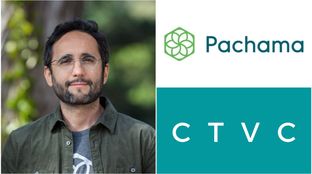
🌎 Get ready with me: Government grants edition 💅💵
A founder’s guide to winning non-dilutive funding with Elemental Excelerator
This week we sat down with co-founders Ryan Shearman and Daniel Wojno and CMO Robert (“Bob”) Hagemann of Aether Diamonds to learn more about how they make “diamonds from thin air.”


Ryan Shearman, Co-Founder; Daniel Wojno, Co-Founder
This week we sat down with co-founders Ryan Shearman and Daniel Wojno and CMO Robert (“Bob”) Hagemann of Aether Diamonds to learn more about how they make “diamonds from thin air.” Described by Forbes as the “Tesla of diamonds,” Aether produces the world’s first carbon-negative carats using sequestered CO2. Just a week into their public launch, with an already vastly oversubscribed waitlist, we explore Aether’s influence as a brand for climate impact.
How did you get into the business of alchemy?
It all began ten years ago when Dan and I met while working for David Yurman, a large international jewelry brand based in NYC. We initially bonded over a shared appreciation for motorcycles and engineering and what began strictly as a working relationship quickly turned into lasting friendship. From there we fast forward to 2018, about five years after our career paths had diverged. Dan was living in Thailand, working for one of the biggest jewelry companies in the world and I was in New York, contemplating my next move after my previous company was acquired. I wasn’t sure exactly what I wanted to work on, but I had started paying much more attention to climate issues and knew that’s where I wanted to make an impact. My wife had given me a copy of Drawdown and I found myself immediately intrigued by Direct Air Capture (DAC) and the role it could play in decarbonizing our environment. At the same time, Dan was experiencing firsthand the challenges of living with the poor air quality in Bangkok. He was wearing masks before it was cool. We found ourselves talking more and more about air pollution and it became apparent to us both that humanity really needed tech-enabled drawdown solutions and needed them fast.
Looking at climate and DAC through the lens of our previous experience in jewelry is what led to our “aha” moment. We realized that diamonds are just crystalline carbon – perhaps the most enduring and valuable form of carbon known to man. We developed a thesis around how we might be able to sequester carbon into diamonds and do so in a way that would generate profits that we could use to fund further decarbonization work. We envisioned it as an economic engine for change. We quickly recruited Anthony Ippolito, a chemical engineer working in sustainable fuel synthesis, who became our third co-founder. We met Bob Hagemann in 2019, who joined shortly thereafter as our CMO. With a well-rounded management team in place, things started progressing rather quickly as we worked to turn pollution into solution.
Where is the product today?
Today, we are in production and working like crazy to fulfill a growing waitlist of orders. It has been no easy task to get here. It has taken us nearly three years and countless hours to solve some extremely complex engineering challenges. To give some background, the product requires three independent technologies in order to be made: direct air capture on the front end, diamond synthesis at the back end, and an entirely new technology to bridge the gap between them. That’s where we focused our engineering efforts.
We realized rather quickly that we would be best served by focusing on the middle portion of the process and partnering with established companies who already have a handle on DAC and diamond synthesis. We started by talking with companies that had already established themselves as experts in that space. We found that most people were really receptive and interested in exploring this concept, perhaps because there’s something magic about making diamonds from thin air. It’s a sexy story and it’s easy to understand.
Going into 2020, our focus was expanding our partner relationships and producing our first rough diamonds. Then COVID hit and everything slowed down. Our aspirations for a summer launch were dashed. We kept pushing and were able to kick off the first phase of diamond production in the fall, followed by the public launch of our jewelry line in December. We received some great press coverage following our launch, which has given us the opportunity to tell the world about our mission, why we incorporated as a public benefit corporation, and what we are doing to have an outsized impact on global decarbonization efforts.
What is the supply chain, step by step from air to diamond?
At a super high level, we take mid-grade CO2 from the air, purify it, and then convert it into hydrocarbon gas that is perfect for growing diamonds using chemical vapor deposition (CVD) reactors.
Growing diamonds in a lab is not new, but doing it well is still quite challenging. Diamond crystals are extremely sensitive to imperfections when they are forming. They simply will not grow, or will crack or turn a very undesirable yellow/brown color in the presence of certain contaminants. A key part of our process is the purity and mixture of our proprietary hydrocarbon gas.
Within the CVD diamond reactor – which is about the size of a refrigerator on its side – is a little grow plate where you put your diamond seeds (a really thin wafer of a diamond). We close the machine up, inject our hydrocarbon and a blend of other gases, and blast it with a microwave. This excites the hydrogen into a plasma state and the carbon breaks off and precipitates down onto the seeds like snowflakes. The free carbon atoms bond with the diamond seeds and begin to grow vertically, like snow accumulating on the ground. Four weeks later, the pieces of rough diamond are large enough to be cut and polished into gemstones.
What is the core technology?
Our core tech is essentially upgrading DAC CO2 into a CVD-grade input. We have developed some IP around the removal of undesirable elemental contaminants that would make this otherwise impossible. There are also some important parts that will be kept trade secrets.
Our hydrocarbon is not the same as what the rest of the market uses to make their diamonds. Other diamond growers source their carbon from fossil fuels. Ours comes from the air, which results in a unique mix of trace elements in our gas. You need a finely tuned “recipe” to create gem-grade diamonds, which requires a team of PhDs with highly specialized skills years to develop. As the first company to commercialize diamonds from air, we have a strong head start that will enable us to seek protection on additional pieces of novel IP before other companies even know where to look. Between patents and keeping certain elements as trade secrets, we’re very confident that we’re establishing a strong technical moat.
Our technology also unlocks a marketing advantage. The hydrocarbon gas our competitors use comes from fossil fuels and is obtained through oil drilling or fracking. So, as much as other brands may claim that they’re sustainable, their use of fossil fuels makes that fundamentally untrue. We believe our legitimacy as the only truly sustainable diamond brand in the market will resonate with the growing segment of consumers who actually care and spend their dollars accordingly.
Beyond sourcing DAC carbon, what else is Aether doing to decarbonize?
We approach decarbonization in a couple of different ways. Our process uses a fair bit of energy, so the first thing we do is source renewable or low-emission power to cover our production needs. The next phase of growth for the business comes from vertical integration, in which we’ll generate our own clean power on site. We aim to generate an excess amount of clean power that we can send to the grid by 2023.
We also allocate a portion of the profit from every transaction to funding promising decarbonization initiatives all over the world. Simply offsetting our own operational footprint isn’t enough for us – we want to ensure a net negative carbon footprint for every carat of diamond sold. Beyond energy use, our packaging and jewellery boxes are made from post-consumer recycled materials including sustainably produced wool and ultrasuede – a combination of plant-based biomaterial and recycled plastic. Every single element of Aether is sustainably-minded.
It’s very exciting to see the economic engine we envisioned coming to life. As we continue making diamonds, we’ll put more and more money into carbon sequestration. We hope to remove our first million tonnes of carbon from the air within the next 18-24 months.
How do you compare and price lab-grown diamonds to mined diamonds?
Digging a diamond out of the ground is expensive – financially, environmentally and, often, socially. Compared to mined diamonds, regular lab-grown diamonds are a step in the right direction; you don’t have to dig a giant strip mine, destroy local ecologies with acid mine runoff, or suffer human rights abuses. We started Aether because we believed we could go even further.
Today, regular lab-grown diamonds give consumers more bang for their buck than mined diamonds. You can typically get a much larger lab-grown diamond for the same price as a mined diamond. Up until now, no luxury brands have used lab-grown diamonds. We hope to bring these brands in as partners in the future to turn what has historically been a harmful liability into something we all know and love. For now, we only sell jewelry pieces through our direct-to-consumer brand – not loose diamonds. Our beautifully-designed modern pieces allow us to charge a luxury price.
Every industry has gone through an evolution where the perception of value changes. When consumers are willing to spend more money on something because of a specific quality, a predominant new standard emerges. Organic food is a good example. The organic label is the new standard which a lot of people are willing to spend more for – even though the product difference isn’t obviously visible. The same thing is true for lab-grown diamonds; the benefits cannot be perceived just by looking at the thing. Aether is going one step further.
Two-thirds of the diamonds sold in 2019 were sold to Gen Z and Millennials. These are the first generations willing to vote with their dollars. They want a brand that shares their values, and they’re willing to pay more for it. In the luxury jewelry space, they don’t have an option to vote for right now. We like to think that we’re the first option that will give them that choice.
How does carbon-to-value scale?
Consumer participation and demand ultimately drive corporate behavior. Corporations drive the vast majority of global emissions, and that won’t change without government regulation and true bottom-up demand. Hopefully, Aether can help spur action.
There aren’t many consumer-facing products that utilize captured carbon. Some corporates are infusing captured CO2 into cement or carbonated beverages. Aether is pushing the boundaries of products with a “wow factor” that consumers can buy directly. As we start to tell that story, we can spread the word about carbon capture to the average person.
Likewise, we’re incredibly proud that the International Gemological Institute certified our first diamond and will be our certification partner for Aether. We’re in initial talks with IGI about changing the standard for diamond certification to include its carbon source and environmental impact, effectively adding a 5th C to the way the world looks at diamonds. This is literally how we change an industry and set a new standard for shoppers.
What’s the consumer demand so far been like?
We’ve had overwhelming demand for our jewelry so far. The website went live on December 21, and, even amidst all of the craziness of the holiday period and news cycles, a record number of people signed up for our waitlist. The numbers exceeded our wildest expectations. It’s both fantastic and scary that we have such a huge waitlist.
How big could this get? What revenue goals are you targeting?
Extrapolating from just the first couple of weeks of interest, and being conservative, I think we can hit $5-6m in top line revenue this year. Out of the gate, we have a pretty strong 65-70% gross margin, even with a ton of inefficiency. As we vertically integrate and scale, we believe this type of business can have 90% gross margin – before accounting for our future external decarbonization work.
What’s your biggest cost?
Unequivocally, it’s electricity – across the board. DAC has electricity costs. Diamond synthesis has electricity costs. The equipment in between has electricity costs. This is why I think that diamonds and DAC are a match made in heaven. We’re ensuring that our energy is sourced responsibly, but the more we can decrease these costs, the better our unit economics will look.
Typically, DAC is vastly more expensive per tonne of carbon than other carbon offsets. Customers might spend $15/metric tonne on your average carbon offset, but DAC can cost up to $1,000/tonne. Of course, there are quality and additionality differences, but DAC’s current unit economics stymies demand. We can amortize that $1,000 cost, so that on a per diamond basis, it’s not a lot of money. Even if that carbon cost went to zero, it wouldn’t significantly affect our pricing.
How are you financing?
When we started, we were very averse to bringing in external capital too early. We bootstrapped and put in our own capital in the early days. We made custom jewelry to self-fund until we were ready to go to market and raise. In 2020, we set out to raise $1M, and ended up increasing that to $1.5M given the initial interest from investors. We had success with an AngelList syndicate led by Sundeep Ahuja (from Climate Capital) and Ketch Ventures, and received investments from Awesome People Ventures, Alpha Bridge Ventures, and a number of angels from the jewelry and tech industries. We’re in diligence with another fund to close out the rest of the round and are considering oversubscribing. We’re glad to be on the tail end of the raise – it really is quite time consuming! We’re excited to get back to doing what we do best: execution.
Get lost in the Aetherverse on Instagram and at aetherdiamonds.com. To explore partnership or career opportunities as the team expands, reach out here.
Interested in more content like this? Subscribe to our weekly newsletter on Climate Tech below!

A founder’s guide to winning non-dilutive funding with Elemental Excelerator

Infrastructure investing for impact with Banyan Infrastructure's Amanda Li

Venturing into nature with Diego Saez-Gil at Pachama